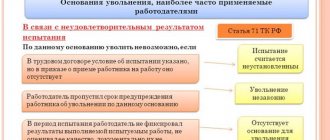One-on-one feedback on time blocks
The program contains an extensive list of actions for both the new employee and the supervisor - a specialist who will “guide” the newcomer.
Communicative ¦Ability to correctly assess and understand ¦ ¦ ¦competence ¦people’s behavior, establish effective ¦ ¦ ¦ ¦relationships; the ability to listen, to present one’s position in a reasoned and convincing manner.
ATTENTION COPYRIGHT HOLDERS! ALL MATERIALS ARE PLACED ON THE SITE STRICTLY FOR INFORMATIONAL AND EDUCATIONAL PURPOSES! IF YOU BELIEVE THAT THE POSTING OF ANY MATERIAL VIOLATES YOUR COPYRIGHT, PLEASE CONTACT US VIA THE CONTACT FORM AND YOUR MATERIAL WILL BE DELETED!
The HR manager conducts sociometry and provides his conclusion along with the sociometry result.
Professional adaptation plan for sales consultant.
FULL NAME. _________________________ Supervisor: ____________________ Mentor: _______________________ Training plan _________________________
| date | Planned result | Actual result | Responsible |
| 1 Week | 1. Seminar “Getting to know the company” | HR Manager | |
| 2. Basic training “Seller School” | HR Manager |
Induction plan
| date | Planned result | Actual result | Responsible |
| 1 Week | 1. Introducing the employee to the department: - structure, goals and objectives of the department; – functions and tasks of the employee; – job responsibilities (according to instructions); – functions of other employees in the department; – internal labor regulations; - safety regulations; – procedure and criteria for passing the probationary period. | Supervisor | |
| 1 day | Assigning a mentor to a new employee | Supervisor |
Professional adaptation plan
| Internship period | Place of internship | Topics discussed at this level | Responsible |
| 1 Week | Workplace | 1. Study of quality standards for customer service. 2. Study of regulatory legislative documents. 3. Studying the rules of working in the Information system. | Supervisor |
| 2-5 week | Workplace | 4. Study of the product range 5. Study of the requirements for the design of the sales area: price tags, pre-sale preparation, advertising support.6. Practical study of the principles of product display. | Leader/Mentor |
| 6-8 week | Workplace | 7. Practical work in the Information system. 8. Study of product flow within the department (daily replenishment of assigned equipment with products, study of customer demand, ordering products from the central authority) | Mentor |
| 9-12 week | Workplace | 11. Practical work with the buyer 12. Independent work, according to functional responsibilities, under the supervision of a mentor | Mentor |
Monitoring the implementation of the plan
| date | Target task | Actual result | Responsible for carrying out |
| 4 week | 1. Assessment of the employee’s theoretical knowledge (assortment test) | Supervisor | |
| 8 week | 2. Assessing the employee’s practical skills (solving practical tasks, testing knowledge of basic regulatory documents for working on cash register machines) | Supervisor | |
| 12 week | 3. Comprehensive assessment, in accordance with the regulations for determining the qualification category of sales assistants/cashiers | Supervisor |
Assessment of the adaptation process
| Successfully completed all activities, adapted well to the position and working conditions | Completed all activities, adapted to the position and working conditions | Didn’t complete all the activities, poorly adapted to the position and working conditions | Partially completed the events, did not adapt to the position and working conditions | |
| Head of department | ||||
| Mentor | ||||
| HR Manager | ||||
| Final result Agreed by: Manager (signature) Mentor (signature) HR Manager (signature) | ||||
Appendix No. 2
Professional adaptation plan for Sales Representative (TR)
Employee: ______________________ Manager: ___________________ Mentor: ______________________
| TA Induction Plan (2 weeks) | |||
| date | Events | Responsible | |
| Getting to know the department. Traditions, structure. | – introduce all working employees to the new TP (full name, position, area of work and area of responsibility, on what issues he can help at the first stage of work, etc.); – provide a list of employees with positions and telephone numbers to make it easier to navigate the team; – familiarize yourself with the working and utility rooms of the department. | Supervisor | |
| 1st day. | Job responsibilities. | – conduct a conversation according to the job description, discuss all areas of responsibility, and have the person sign the instructions; – give a copy of the job description to the employee; – talk about corporate ethics and appearance requirements. | Supervisor |
| 1st day. | Workplace. TP documents. | – show the TP workplace; – provide the necessary labor tools (diary, stationery); – explain how to use the telephone, fax, and other technical means necessary for work; – familiarize yourself with TP documents (task plans, reports, printouts from directories, marketing tools in work and rules for their use); – familiarize yourself with the motivation system. | Supervisor |
| 2nd day and further for 3 months. | Practical task. Studying the assortment in the catalogue. Preparing a personal copy of the catalogue. | - organize a study of the assortment according to the catalog - begin familiarization with product groups (paper - technical characteristics, catalogs of Russian and imported paper, etc.). - studying the assortment. (At the same time, give specific tasks, for example, learn 10-20 product positions). – at the end of the working day, sum up. | Leader/mentor |
| 3rd day | Practical task: Study of existing services, promotions, press releases | Print out complete information about current service programs and promotions. Explain to the intern what clients the promotion/program is intended for and methods of promotion. Monitor the trainee’s assimilation of information by asking control questions. | Leader/mentor |
| 3rd day | Studying pricing policy | Print the pricing matrix depending on the transaction history and the client’s current transaction, talk about possible exceptions, and explain the rules for working with the client. | Leader/mentor |
| 4th day | Practical task: Studying information about competitors | Provide information about the main competitors (competitor passports) | Leader/mentor |
| 4th day | Familiarize the TP with the assigned segment | Show the segment on the map, describe the boundaries in detail, print a street traffic graph, familiarize yourself with the areas on the assigned segment. Familiarize yourself with statistics on this segment (dynamics of turnover, influx of new customers, average shipment amount, loyalty, number of customers making transactions). Print monthly turnover of clients from the data warehouse, introduce the segment of large and Premium clients. | Leader/mentor |
| 5th, 6th, 7th. | Access to the territorial segment | Access to the territorial segment. | Mentor |
| 8th day | Working day algorithm. Control of basic skills. Entering a segment with a mentor. | The mentor explains the algorithm of the working day (morning-evening system) and provides the necessary marketing tools. Enters the segment and monitors the work of the TP with clients. After each visit, the mentor provides constructive feedback. Tests basic skills and determines the TP’s readiness for independent work. | Mentor |
| 9 day, 10 day | Independent access to the segment. | Office visits twice a day (morning and evening). The TP receives a planned task that contains the maximum number of main clients. The manager issues a planned task and discusses with the technical support the purpose of visits to each client. TP independently processes all clients in the segment. | |
TP performance indicators.
| Month |
Qualifying exam
Without presenting this document, the Sales Representative is not allowed to take the exam.
| date | Notes | Result | Instructor | ||||
| Assortment knowledge test | |||||||
| Option No.______ | |||||||
| Option No.______ | |||||||
| Option No.______ | |||||||
| Possession of sales skills at the “Specialist” level | |||||||
| Performance indicators (3 month average) | |||||||
| Average value | |||||||
Conclusion of the qualification commission: Sales representative__________________________
Date "__"___________202_
Appendix No. 3
Table “Assessing the effectiveness of the mentoring program”
| Evaluation parameter | TP | Database operator | Salesperson/cashier/consultant | Sales manager | Total | Previous period data | Dynamics % |
| % turnover during the probationary period by category | |||||||
| Number of people dismissed during the probationary period | |||||||
| PN went well | |||||||
| PN went well | |||||||
| PN passed satisfactorily | |||||||
| Average score on assessment of professional knowledge | |||||||
| Number of trainees | |||||||
| Number of mentors |
(Updated 02/01/2020)
Curator position _________________________________________________
A good tool to support the professional development of sales managers. Allows you to assess current skills and plan further training. The memo will help the head of the sales department to meaningfully conduct training, focusing on...
A calendar of meetings with the immediate supervisor is drawn up according to the principle: the first week - every day after work, the second week - once every two days, etc.
All this can be avoided if you clearly, clearly and consistently explain to the new employee what he must do from the very beginning.
Studying the operation of corporate computer programs and software products used in the department.2.1.
Training needs assessment
The need for educational activities is determined by a specialist in training and personnel development, if there is one in the company, or an employee performing his functions. The following methods are used for this:
- analysis of the employee’s personal file - it is established how long ago he received his education, whether he took advanced training courses;
- analysis of the employee’s performance - usually carried out when hiring a new specialist;
- collecting applications for study - they are submitted by both department heads and employees themselves;
- certification - based on the results of such assessment of knowledge, a special commission makes recommendations for study.
FULL NAME. curator _____________________________________________________
Personnel management specialists note that the final “infusion” of a person into the company occurs within 10-12 months.
When introducing a new employee to a position, it may make sense to once again remind him of the basic terms of the employment contract. You've likely raised these questions during your interview.
It is worth spending the necessary amount of time on all the questions listed above. If a new employee feels welcome from the very beginning and feels part of your team, he will perform better. This way he will become an active member of your work team much faster.
Therefore, it is important to set up the adaptation process. A well-functioning system saves time and resources for the company and employees, allows you to get a newbie up to speed as quickly as possible and start getting results from him.
Plan for entering the position during the probationary period
Acquaintance with employees of other departments with whom the new employee will interact due to the nature of his duties.
Where to start, where to end, how to navigate this? A person gets lost in a scattered knowledge base and becomes even more demotivated.
Instructions for fire safety inspection of the premises at the end of the working day. The procedure for employees of XXX LLC in case of fire, natural disasters and other emergency situations. The procedure for officials to act in the event of an industrial accident at XXX LLC.
Where to start, where to end, how to navigate this? A person gets lost in a scattered knowledge base and becomes even more demotivated.
Instructions for fire safety inspection of the premises at the end of the working day. The procedure for employees of XXX LLC in case of fire, natural disasters and other emergency situations. The procedure for officials to act in the event of an industrial accident at XXX LLC.
Its main task is to quickly and easily introduce a newcomer to the course of business, familiarize himself with the team and job responsibilities.
Studying the package of documents ¦ ¦ ¦ ¦ ¦regulating the work of ¦ ¦ ¦ ¦ ¦company employees: ¦ ¦ ¦ ¦ ¦1.1.
It should be noted that the adaptation process includes several stages, and different companies practice both simplified options and more complex, structured programs.
Do not appoint people who have applied for the position as mentors. They can harm the employee in every possible way, trying to get him to leave the company. Choose only friendly employees who are open to communication, ready to share their best practices and go into all the details of performing their job duties.
The induction plan helps a new employee in the company understand what is required of him in the next three months, and the new employee’s manager can objectively assess the results of the probationary period, based on the work plan, comparing it with the actual situation.
This sample onboarding plan will help you organize and document tasks and responsibilities when onboarding a new employee.
Familiarization with the location of all buildings and structures of the enterprise in the city. 2 Personal or public transport. Plan I.
Let's say you hire a new employee. What would you tell him before he starts his official duties? Write down your thoughts on this matter.
As Head of QA department, I regularly hire people, and the question of their adaptation also regularly arises. But not only I, but also other companies ask this question when they need to move a new employee into the current reality. The issue of onboarding is now on the wave of popularity.
Personnel adaptation stages 2021: step-by-step program
In this article, we will talk about what adaptation is, how to create an effective personnel adaptation strategy, and describe in detail the plan for this process.
Companies spend a lot of time and money hiring the best talent. Therefore, it is very important to make sure that new employees will remain in your company and will work for you long and productively. The first step to achieving this goal is an effective onboarding process that will help employees feel comfortable in their new workplace and quickly get involved in their work.
What is personnel adaptation
Everyone is faced with the need to get a new job and join the team. This process in the language of labor legislation is called labor adaptation. The faster the staff adaptation process goes, the easier and more logical it will be for a new person to join the workforce.
Otherwise, a person who lingers in the habituation phase will not be able to establish relationships with the work team and will subsequently become an outcast among his colleagues.
The situation, of course, depends on the employee himself, on his ability to find a common language with other people, build relationships with colleagues, on his professional knowledge and skills, and the level of his psychological preparation.
Successfully completed professional adaptation of personnel indicates a high level of moral and material reward in the future, receipt of social recognition and other benefits.
Goals and objectives of personnel adaptation in the organization
Organizing the management of career guidance and personnel adaptation is the work of the personnel department and the head of the department where the new employee works.
Adaptation is an important point in personnel management, which determines which personnel will work in the organization, what the psychological climate in the team is and how well and productively employees will perform their duties.
The goals of the work on adaptation of new employees are:
- accelerating the process of introducing a new employee to the job, familiarizing him with his job responsibilities;
- complete elimination or reduction of staff turnover in the organization;
- motivating employees to be interested in the result, to be motivated to perform their job duties better, and to give maximum return to their work;
- increase in labor productivity;
- improving the psychological climate in the team.
Only taking into account all the listed factors and working in this direction will give the best result.
conclusions
Great onboarding programs cover much more than a day or even a week. They can last 90 days or even a year.
Good programs engage HR managers, executives, recruiters and new employees and create a strong sense of team identity and shared purpose. Remember that your company culture is renewed every day by leaders and employees.
To ensure the onboarding process evolves with the culture, your leaders and HR professionals must commit to reviewing and improving the onboarding experience over time.
In order to automate processes and improve onboarding programs, it is worth using special software. Hurma System helps HR managers, executives and employees communicate with each other quickly and effectively. For example, in the system you can schedule welcome and onboarding meetings in a few clicks.
Your onboarding program can be a true differentiator that energizes the people you hire today and attracts the talent you need in the future.
Stages of personnel adaptation
Adaptation of personnel at an enterprise is a delicate and multi-stage process. Each organization has a program and its own developed approaches to solving this issue.
But all possible stages of personnel adaptation can be divided into:
- Primary (preparatory). After hiring a new employee, the manager introduces him to the rest of the team. Introduces the employee himself to his new workplace, appoints a curator (a more experienced employee who will help the newcomer at the beginning of work), and completes the preparation of all necessary documents. This stage may include familiarization with the history of the enterprise, its structure, mission, products, procedures, and rules of corporate ethics.
- Theoretical (training). At this stage, the employee is introduced to the theoretical part of his main job, functional responsibilities and requirements for further work performance.
- Practical (application of knowledge). Directly performing some practical tasks: first under the supervision of a mentor, then independently.
- Final (passing the probationary period). It consists of summing up the work of the new employee. It is assessed how successfully he settled into the new team, managed to master new skills, and integrated into the team. At this stage, the employee’s strengths and weaknesses, his successes and failures are already visible. Based on everything taken together, management makes a decision on its future fate. Whether he passed the test and will continue to work or not, and the company no longer needs his services.
Based on the foregoing, one can understand how labor adaptation of personnel is an important and serious thing, and that this is one of the indicators on the basis of which a decision is made whether the applicant will remain in the organization or will look for work elsewhere.
The main problems of newly employed people
The main enemy of any person is their own fears. Especially if he does not have enough experience to feel confident in his abilities. Sometimes this becomes the reason for his quick dismissal - the inability to understand the processes and relationships of the team.
What phobias will you have to fight:
- lose your job;
- fail to cope with responsibilities;
- miss deadlines or stages of project delivery, and let other people down;
- not making friends with the people, getting an enemy in the department;
- notice that there is not enough fundamental knowledge to carry out simple tasks;
- appear stupid or unprofessional in front of your superiors;
- quarrel with management.
Another reason why staff should not be released onto the line without an adaptation period is that if they do not understand what needs to be done, they will quickly write a letter of resignation. The pattern is that beginners don’t like to ask again, and mentors don’t like to tell things several times.
A successful example of adaptation
Adaptation of personnel in the organization, using the example of one of the companies, occurred as follows. More experienced employees were assigned the role of mentors. The employee in charge of the newbie onboarding system downloaded data from the accounting system daily about people who needed to return to work soon. Each person was manually assigned a different mentor.
They had to work in pairs. Mentors were selected from any department, except the one where the newcomer would work in the future. It is more convenient to work in pairs, taking into account different workload schedules, and it is easier to communicate with strangers.
Once mentors were approved, automatic notifications were sent to them, and a reminder was added to the calendar about the day the new employee would start.
The day before, the mentor called the newcomer for correspondence acquaintance and so that in the future the newcomer would contact him upon arrival at the office to meet and discuss work issues. The mentor must check whether everything is ready to accept a new employee, make sure that the workplace is organized, and remind the head of the department where the newcomer is getting a job about the new employee’s departure.
On the first day, a pair of mentors meet the new recruit in the morning, talking about the available information on the corporate portal. This takes a couple of hours. This meeting makes it clear to the employee that he was expected.
On all other days, if questions arise, he can contact his mentors, ask them questions to solve any situation, from a broken chair to a conflict situation with another colleague, and they help resolve them.
At the end of the probationary period, the employee must evaluate the work of the mentors and their assistance. Mentors are awarded points for this, which subsequently affect their financial incentives.
And now - in all the details
Organizing the adaptation of new employees begins with finding out what level of preparedness each of them is at. Based on this, a set of adaptation measures is selected (in each case individually). The workplace should be prepared for the employee's first arrival.
If we are talking about production activities, it is necessary to ensure the availability of the necessary tools and a set of work clothes (their size can be indicated in the application form when applying for a job).
If the new job is of an office nature, a completely free desk with a chair, a computer and other necessary equipment will be organized.
When a workplace needs to be supplemented with any new equipment, the need for this must be reflected in advance in a special application sent to the administrative and economic department.
An approximate plan for getting into the working rhythm should be sketched out by the manager in advance or exist in the form of a standard “Personnel Adaptation” template for the main range of available positions. This document should not exceed a page in length.
The newcomer must be assigned a mentor, and the issue of undergoing a medical examination must be clarified with him. The team is informed about the arrival of a new colleague. If a candidate is being considered for a leadership position, he is usually asked to get to know his future subordinates before going to work.
Personnel adaptation methods
The research program for the personnel adaptation system identifies the following forms of personnel adaptation:
- mentoring (providing assistance at the initial stage of work by a more experienced employee through consulting, introduction, assistance in getting to know the team);
- attending trainings and seminars (training and developing certain employee skills, for example, communication, public speaking skills, preparing presentations, developing stress resistance, etc.);
- conversation (an introductory conversation between a newcomer and a HR manager, supervisor, or HR department employee, during which the employee receives answers to his questions);
- a specialized program (for example, educational films or team role-playing games aimed at team building);
- excursion (sightseeing tour of the organization, its structural divisions, territory, familiarization with the history of the company, employees, corporate culture);
- request for feedback (at the end of the period of adaptation and completion of the probationary period, the employee is asked to fill out a feedback questionnaire);
- other methods (corporate events, certification, testing, training, etc.).
Types of personnel adaptation
Adaptation can be of the following types:
- professional involves learning new special skills, acquiring a new one or improving an existing skill or professional skill. This type depends on the desire and ability of the beginner to learn, the desire for new knowledge, and his ability to learn. This also includes preparing the workplace and providing all necessary materials;
- socio-psychological implies a person’s adaptability to work in a new team, under the leadership of a new boss, submission to the traditions, norms and rules of behavior that have developed in the organization;
- organizational is based on the employee’s understanding of what is required of him, working with job descriptions, determining his place in the structure of the enterprise, and participation in the production process.
Only an integrated approach to professional and psychological adaptation leads to the successful completion of the probationary period by the employee and saves the company’s costs on searching, training and evaluating personnel.
Basic Steps
The process of employee adaptation in an organization is the implementation of sequential actions. It is important to develop and organize them in advance in order to apply them in a proven form.
In order for an enterprise and a newly hired specialist to mutually like each other, it is necessary to complete 4 successive stages:
- Information. All data about the person, his status and marital status, education, acquired skills and profession are collected. Then they ask him what he needs for full-time work - manuals, instructions, what he needs help with. After all, even if he is a specialist with ten years of experience, he will not feel comfortable working in a new place. Therefore, “problematic” parts are identified and will be corrected.
- Well. In circumstances unfamiliar to the newcomer, the mentor lays out for him the path along which he will move. These are instructions, simple tasks, supervised practice, internship - depending on the developments of the adaptation period and the complexity of the future position. It is important that a person understands what requirements and standards he has to work with.
- Inclusion. When the first two weeks have passed and the newcomer has already gotten used to it, has begun to communicate with colleagues, remembers their names, and also remembers what and how to do, a turning point comes. He still has mistakes and tension, but he already understands how everything works here. At this time, he decides whether to continue making mistakes or give up this idea.
- Become your own. We can say that the infusion has been successfully completed when the new person turns into a colleague. He communicates calmly and with humor with other workmates and is not afraid to ask for help. He fulfills his duties, sometimes more slowly than others, but the dynamics and desire for growth are noticeable.
What does the adaptation program consist of?
An employee adaptation program is a plan for introducing an employee to a position. This document is needed to apply a uniform approach to the adaptation procedure across departments of the organization. The document is an extensive list of actions for the adapting employee and for his supervisor, who will help adapt to new working conditions.
For an employee, the most difficult period is the first two to three months, which usually coincide with his probationary period. Often the duration of the program is equal in length to this period.
An optimally formed program is characterized by the following features:
Source: https://bogunskaia.ru/lgoty/plan-adaptacii-novogo-sotrudnika.html
Sample New Employee Introduction
What is it usually adapted to? In basic things: people, everyday issues, product and its market, processes, architecture, company, regulations, traditions, tools. But a newcomer is rarely adapted on all counts, and more often than not everything goes according to one of four classic scenarios.
On the contrary, in enterprises where personnel work with “maximum efficiency,” management does not expect a “miracle” from recruits, no matter how excellent experience, ingenuity and initiative they have.
The purpose of the meetings is to help a person adapt to the company faster and easier. And also to determine a person’s strengths and aspects that need to be developed for successful work, to determine his motivation and potential.
The student’s task is to find and read out an algorithm for his actions in a given situation. In this case, the employee supplements the wording with the word “I”. That is, the correct answer will be “I + step a.” I + step b. I + step c. ..."
INTRODUCTION PLAN FOR A NEW EMPLOYEE
Filling out various types of documents related to the activities of the enterprise. Drawing up planned estimates, projects Personal qualities that will allow you to win over the team in a short period of time and earn trust, such as: responsibility, attentiveness, perseverance, communication skills, responsiveness, honesty, etc.
At the initial stage, he should be given a very specific task with a result measurable in specific numbers or other indicators. It must be realistically feasible based on the knowledge and skills that a person possesses without additional training.
If you do not help and guide newcomers, the image and reputation of the organization may suffer after they leave.
A clear job description for each employee is an indispensable condition for the activities of any company. A specific result of work can be assessed using clearly formulated criteria, which a beginner should also be introduced to.
And today I want to bring to your attention an approximate “skeleton” of such an adaptation plan, which you can modify to suit your organization. For convenience, the training program is divided into small thematic blocks, each of which contains a description of possible tasks for trainees, as well as explanations for the employee responsible for training personnel. Next, ask the employee questions to find out how carefully he listened to you and whether he remembered the main work aspects well.
One of the pains clients have when searching for commercial staff is when an employee quits without even working for a month. The reasons, as we know, can be completely different, from inappropriate promised working conditions with a new employer to a change in family...
The document describes the rules for conducting a shift meeting in a restaurant and provides a “Shift Meeting Sheet” that can be used as a plan for the leader, as well as a daily mandatory form for all waiters. The document is suitable for use...
Work plan and first steps of a manager in a new place
Being a leader is most likely your conscious choice. This is when, instead of “receiving money,” a person chooses “earning money.” About making difficult decisions and responsibility. And also about creating a coherent, continuously functioning system of processes that influence the world.
Only when you sit high, there are also hundreds of times more tasks and problems. In this article we will deal with some of the first things - how a new manager can prescribe an adequate work plan and what first steps to take in a new place .
We build on the experience of our clients from different areas of business. We present the most illustrative situations in the form of cases (problem/solution).
The first steps of a manager in a new place
The adaptation period for a boss has been described many times in articles on many management portals. Among them are examples of recommendations from:
- HR-s
- psychologists and coaches
- from existing entrepreneurs and managers
Which ones should you take into account? Each side preaches its own approach. Customer experience shows that everyone has a place. However, there are a few features that you need to be sure to consider.
First, any information is useful in context. If you have managed one company for the last 20 years and moved to another, or if you are new to the position, the strategy will be completely different.
Secondly, in order for you, as a manager, to have a truly effective plan, you need to clearly understand the goals that you set (or the owners set for you).
We have seen several rather strange cases when subordinates really liked the new manager, brilliantly presented the enterprise’s action plan for a year, but after 3 months it became clear that real performance and even discipline had deteriorated.
That is, the person beautifully “sold himself and his plan” to everyone, but there seemed to be no meaning behind him.
Where to start writing a work plan for a new manager
If you have clearly defined your goals for your new position, understand that there is serious work ahead, and, at the same time, intend to write a plan that will be useful for the company, we suggest starting with the following:
Then, with these sketches, you go to the owners, discuss, and get feedback. Sometimes owners involve business coaches, who help them look at the developments from the outside and draw the right conclusions for each of the parties.
Only after such a meeting will you begin to “get into” the current state of affairs, and will you be ready to write a basic, real work plan.
Before drawing up a plan, you need to delve into business processes
A new director was hired at one of the private clinics in Kyiv. They hired a person with no experience in the medical field in order to introduce promotion methods that were unusual for her. Previously, the clinic was run by the owner, and we were invited to help the new director take over the business and develop a plan for the year.
After analyzing the job descriptions, possible bottlenecks in communication between these two people, as well as the personal concerns of each based on the results of the survey, we organized a plan for weekly supervision. The new manager worked at the clinic for a month in various administrative positions under the supervision of a full-time employee.
After just 3 weeks, the manager showed a good understanding of the clinic’s processes. And after 4 weeks, a plan was ready, approved by the owner.
What is scheduled should not be local
An enterprise producing mineral fertilizers has been operating in Kharkov since the 1990s. After the outbreak of hostilities in the eastern regions of Ukraine (and a corresponding decrease in demand in these regions), the owners decided to hire a new head of sales.
We participated in the recruitment process. The difficulty was that the candidates proposed various plans for the development of the sales department, lobbied for the hiring of familiar sales trainers, etc.
Most of them were quite logical, but according to the experience of our consultants, such innovations would most likely cause sharp rejection among ordinary department employees.
That is, we would additionally have to fight with them, as often happens.
We developed a questionnaire consisting of blocks for owners, employees, as well as 2 key clients (with whom personal relationships were established). As a result, based on bare statistics, they were able to choose a leader according to a plan that was moderately ambitious, aggressive, and moderately took into account the vision from the inside.
The point is that your plan must balance the interests of all parties. Then the chances of successful implementation will increase significantly.
First 100 days and plan
One of the retail chains had to hire a new manager just before the New Year. Recruitment agencies invited more than 15 applicants, and the owner personally approved the final candidacy. But during the corporate event, the new boss showed himself to be a fanatic of implementation and change.
Warmed up with alcohol, he read out a list of items from his diary, what would change and when. He entered into polemics with whomever he had to, argued, shouted “you think small and understand nothing.”
It is natural that the employees began to form friendships against him and his changes, although for the most part they were quite literate.
There is a common truth - a new leader in the first 100 days of his work must be very careful not to cause harm (even if not intentionally), not to make things worse. You must pause and give your subordinates the opportunity to get used to your management style.
Plan Structure
Technically, the manager’s work plan contains the following sections:
- Goals to be achieved
- Stages (periods) with measurable intermediate results
- Tasks for each stage, indicating deadlines, required costs and performance metrics
- Performers and responsible persons for each task
- Rewards/penalties for completing or not completing each task
Very similar in essence to a business plan. The task is also to show the liquidity of each action, describe the processes, justify each of them, and predict possible benefits.
You can move away from it, but you must touch on the listed points.
Results
The first steps of a manager in a new place must be verified. We saw this from the examples given from the lives of our clients.
Don't suddenly rush to propose changes. This can discredit you as a leader. Start with adaptation to the new place. Let your colleagues adapt to you. Get the owner's support. And then all planned actions will be appropriate and correctly implemented in the eyes of both employees and owners.
If we can be of assistance to you in the planning process, please ask questions by contacting us in a way that is convenient for you. We will answer them with joy and free of charge, because we want new leaders in Ukraine to take office effectively and understand which steps should be taken first and which ones to avoid.
What does the adaptation program consist of?
The person begins to blame management and other employees for surviving him and creating unfavorable working conditions.
It should be made clear that the new job offers good prospects for professional development and growth. From the very beginning, you should outline possible career prospects and the actions required to achieve them. It is advisable to train new employees using introductory materials. Attention Motivation (for the Ability to motivate subordinates and colleagues to positions from the level of achieving set goals, increasing the team leader and work efficiency. The ability to change higher) people’s behavior, leading, showing ¦ ¦¦caring for subordinates.








